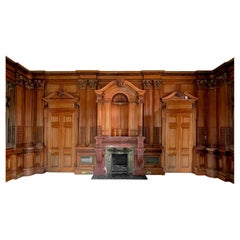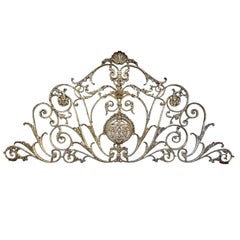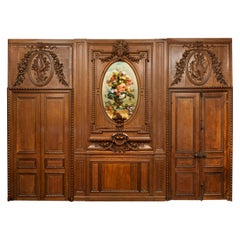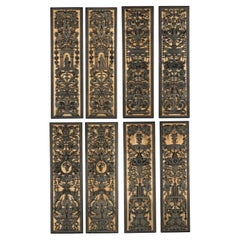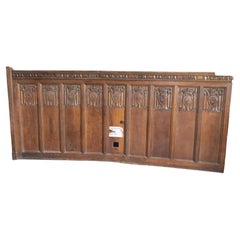London - Panelling
to
181
104
2
Height
to
Width
to
2
1
1
1
1
1
2
2
2
Item Ships From: London
George Trollope & Sons fireplace & room, Paris Exhibition 1878 Gold Medal Winner
Located in London, GB
George Trollope and Sons. Exhibited at the Paris Universal Exhibition in 1878 winning a Gold Medal for Excellence.
The set forms the four sides of a complete panelled room that was exhibited as a boudoir room or petit salon at the Paris Exhibition 1878 .
The main feature and centrepiece of this boudoir room is the Rosso Antico marble fireplace surmounted by an open display niche carved in cedar wood.
Each side of the room is composed of various panels and are as follows:
One side with a grand Rosso Antico marble fireplace flanked by two doorways.
One side with French doors originally opening onto a balcony, flanked by two large bookshelves.
One side with a window flanked by two mirrors. The opposite side with three large mirrors.
The complete room measures:
21 ft / 6.4 m wide, 17 ft / 5.18 m deep, and 12 ft / 3.65 m high.
It could also be used in a number of different combinations to suit various room layouts. The mirrors could be replaced with windows or further bookcases.
Each side is decorated with various sizes of finely carved panels and holds ornate Corinthian style columns surmounted with cherubim's on the capitals. Three cherubs are formed at the top of each corner with three columns, at the column bases there are circular carved pedestals to display statues.
Published & illustrated in the ‘Illustrated Catalogue of the Paris International Exhibition’.
The main part of this room, the Rosso Antico marble fireplace is surmounted by a large open display niche carved in cedar wood are illustrated with a line drawing in the Paris Universal Exhibition catalogue on page 209. The whereabouts of the seminaked caryatids and the marble bust of Alexander Pope are unknown. The bust of Alexander Pope was copied from the original one in Westminster Abbey, London.
The Corinthian columns now flanking the niche above the fireplace are also in cedar wood having the identical carved fluting to the rest of the room and were made to replace the caryatid figures. Those Corinthian columns are period to the room and can only have been made shortly after it arrived back to London and before it was reassembled and fitted into the house built by George Trollope and Sons in the 1880's, and where we removed it all from.
George Trollope made clever use of Alexander Pope's early 18th-century poetical successes in Great Britain and France by using ‘The Rape of Lock’, a mock-heroic narrative poem Pope wrote in 1712 about Petre who cut off a lock of Arabella’s hair without her permission, as the theme of the boudoir room or petit salon at the 1878 Paris Exhibition.
In the original exhibition display of the room set, tapestries depicting the Rape of Lock were hung where the mirrors are now positioned.
Alexander Pope's The Rape of the Lock is a humorous indictment of the vanities and idleness of 18th-century high society. Basing his poem on an actual incident among two families of his acquaintance, Pope intended his verses to quench hot tempers and to encourage his friends to laugh at their own foolishness.
The poem is an outstanding example in the English language of the genre of mock-epic. The 'epic' was considered one of the most serious of literary forms; it had been applied, in the classical period, to the trivialities of love and war. Pope’s mock-epic is not to mock the form itself, but to mock his society in its very failure to rise to epic standards, exposing its pettiness by casting it against the grandeur of the traditional epic subjects and the bravery and fortitude of epic heroes: Pope’s mock-heroic treatment in The Rape of the Lock underlines the ridiculousness of a society in which values have lost all proportion, and the trivial is handled with the gravity and solemnity that ought to be accorded to truly important issues. The 18th-century society in this poem fails to distinguish between things that are important and things that are not. The poem mocks the men it portrays by representing them as unworthy of a heroic culture. Therefore the mock-epic follows the epic in that its main concerns are serious and moral. The point that the theme must now be satirical rather than earnest is symptomatic of how far the culture has fallen.
Retaining the original exhibition label
The back of the panelling still retains two original labels printed with the 'Union Jack' and printed adjacent to it, 'The Secretary Royal British Commission for the Universal Exhibition 1878 Champ de Mars Paris'.
Adjacent to that and below, printed and written in ink vertically:
Exhibitor: (and signed in ink) George Trollope & Sons.
Address: (written in ink) Halkin Street West. London.
Allotment in Block: (written in ink) a2. In the printed floor plan 'a2 square' is in the very first line to the right of the floor plan and handwritten in ink with a 'diamond shape' also written with '101' within it. This pin points where George Trollope's stand was located.
With thousands of items being displayed at the Exhibition, this label would have been the floor plan for the craftsmen, so they knew the correct place to install the boudoir room or petit salon.
The firm continued expanding house building and interior decoration side of the business and by 1849 was also trading as an estate agency, letting and controlling property for the Grosvenor Estates. A separate branch of cabinet-makers, bearing the family name, was opened at West Halkin Street, London. becoming known as 'The Museum of Decorative Arts' (looked after by George Robinson). Here Trollope and Sons also sold high-class antique furniture made by other makers. In 1851, the firm became formally known as George Trollope and Sons. West Halkin Street, London. The address was recorded in the listing for the firm in The Furniture Gazette Directory, 1876 & 1877.
Period Press Coverage & Art Critic Review.
everal newspapers also thoroughly describe George Trollope and Son's stand including the different tapestries that were hung where the mirrors are now, illustrating the poem 'The Rape of Lock', by Alexander Pope.
Marius Vachon, a French Art Critic and journalist, who wrote for the journal ‘La France’ published an extensive review of the Trollope and Sons stand in a book called Les Merveilles de l'Exposition de 1878 (The Wonders of the 1878 Exhibition).
Note: In the World Fairs translation it states door frame, Marius Vachon had originally written ‘chambranle’ in French, 'chambranle' loosely translates to a frame around something, and should read in its correct context: ‘fireplace in rosso antico’.
We have taken the extract below written by Marius Vachon in its translated form from: Les Merveilles de l'Exposition de 1878, (The Wonders of the 1878 Exhibition). This puts into perspective the importance of this fine quality room interior when he viewed it at the exhibition in 1878:
Marius Vachon: English furniture is very curious to observe; irreproachable from the point of view of execution, the furniture of our neighbours always reaches the last degree of respectability and comfort. One thing to be noticed is that for large pieces of furniture, the English upholsterer is transformed into a sort of architect; everything he makes takes on a monumental aspect.
The first object that catches the eye when one enters the furniture class is the beautiful boudoir-salon exhibited by Mr. Trollope. The boudoir (or petit salon), of carved cedar wood, is an attempt to reproduce the style which prevailed in England during the first decade of Queen Anne's reign, and all the details have been studied, but not copied, from examples of decorative work of the time. The fireplace is in "rosso antico" movement, and the ceiling is in portable plaster. The panels painted on canvas represent scenes from the heroic-comic poem "The Abduction of the Hairpin," (The Rape of Lock) written by Alexander Pope in 1712, the eighth year of Queen Anne's reign, in which the customs and mores of the time are satirized in a pleasing manner.
The apotheosis of the Loop and its sidereal transformations will form the decoration of the ceiling. In these illustrations of Pope's charming poem, the costumes and accessories have been taken from models of the time; and the bust of the poet, copied from his tomb in Westminster Abbey, occupies the niche in the centre of the mantelpiece.
M. Marius Vachon, the period writer of the above continues with:
Now we shall mention at random the magnificent dining table of Messrs. Johnston and Co., their oak mantelpiece, their boudoir table; Mr. Watt's drawing-room mantelpiece stepped in the old style and imitating the Japanese; Mr. James Shoolbred's great
The Decorative Arts Society on Trollope and Sons
The boudoir or petit salon is mentioned again in the Decorative Arts Society:
Trollope did not exhibit such highly rated objects at the 1878 Paris Exhibition as at previous exhibitions; items included a large mirror frame carved in limewood in Renaissance style and a satinwood cabinet in Adam revival style, with a similar armchair (illus. Meyer (2006), p. 242) and probably two rooms; one was a boudoir in cedar wood in Queen Anne style and the other was a boudoir decorated by the firm in the theme of Pope’s The Rape of Lock.
In the above extract, it is quite clear that the two rooms mentioned are in fact the very same room, because the fireplace and niche are illustrated in The Paris Universal Exhibition catalogue on page 209 and Marius Vachon describes the rest of the room set in the above…
Trollope and Sons exhibition pieces listed and described by Meyer in an article he wrote for: The Decorative Arts Society 1850 to present, Journal 25 in 2001., where he points out the importance of George Trollope and Sons and mentions a table by Trollope exhibited at the 1867 exhibition that sold for £40,000 in 1996. He also mentions a cabinet exhibited by Trollope at the International Exhibition of 1862 that sold at Sotheby's in 1997 for £150,000.
Interest was not as strong in the 1990's as it is today for rare exhibition pieces, high quality items were abundant back then, it was a golden era when the most beautiful works of art just kept coming onto the market. But there are exceptions as in this instance, when a unique, gold medal-winning exhibition work of art comes onto the market for the very first time.
Meyer continued researching and writing about the great exhibitions and released his book in 2006, 'The Great Exhibitions, London, New York, Paris and Philadelphia 1851- 1900, where he mentions only in passing, The Boudoir Room or Petite Salon exhibited by Trollope, he even states that an image was not reproduced and that Trollope's exhibits in 1878 were not up to the quality and class of the items Trollope exhibited in London in 1862 and Paris in 1868. This is probably because Meyer didn't know of the line drawing illustrating the Roso Antico Fireplace, Niche and Panelling reproduced in The Illustrated Catalogue of the Paris International Exhibition 1878 shown in the above which Geering recently uncovered.
John Meyer continues in the DAS journal:
Undoubtedly they (Trollope) are a firm worthy of further research as they were right at the forefront of the furniture business in London from 1860 to 1880.
Our research shows that the Petite Boudoir was awarded the gold medal for excellence in 1878 (see Journal La Liberté 23-10-1878 with the list of all medals attributed), something George Trollope and Sons did not achieve at the London 1862 and the Paris 1867 exhibitions. Jonathan Meyer joined Bonham's in 1977. He was Director at Sotheby's in charge of 19th Century Furniture from 1994 to June 2007. He was also chairman of the Fine Arts Faculty for The Royal Institute of Chartered Surveyors.
In the original description from the article in Les Merveilles de l’exposition de 1878, M. Marius Vachon states:
The first object that catches the eye when one enters the (English) furniture class is the beautiful boudoir-salon exhibited by Mr. Trollope.
Suggesting, it was in his opinion the very best on display in the English section, and being awarded the gold medal for excellence can only add weight to this.
Adjacent to the original label that was printed by The Secretary - Royal British Commission for the Universal Exhibition 1878 in stencil ‘TO BE KEPT’, i.e. ‘to be returned’. This confirms why it came back to London. We removed the Boudoir Room or Petite Salon from a Trollope house, part of a grand high-class housing estate in London which around the time of the exhibition Trollope and Sons were in the process of building, and where the room set was installed directly after it returned from the exhibition in 1878 until now.
Worthy of note is the machines that did the carving for the Boudoir Room or Petite Salon and also did all of the decorative carving (most of which was linenfold carving) for the Houses of Parliament, London.
This machine, the engraving and description of which we copy from Engineering, was specially designed by its inventor, Mr. Jordan, for assisting in the production of the vast amount of carved decorations required for the walls and ceilings of the Houses of Parliament, London, and it was so employed during the entire progress of the work. The late Sir Charles Barry was so well satisfied with it, that he frequently declared it would have been impossible to have accomplished the work without it. The Department of Woods and Forests employed five of the machines at the Government Works, Thames Bank, for several years; and the machines have now passed into the hands of Messrs. George Trollope and Son, and are still used in the same building.
They also exhibited the new technique of xylatechnography and sgraffito, methods of impressing coloured design into soft wood and engraving veneer to reveal the base wood.
The newspaper, La Liberte October, 23rd 1878 listing the medal winners of the Paris 1878 exhibition. Third column, ''GROUPE III MOBILIER ET ACCESSOIRES'', (GROUP III FURNITURE AND ACCESSORIES). Medailles d'or. (Gold Medals) where G Trollope et fils (G Trollope and Sons...
Category
1870s Antique London - Panelling
Materials
Marble
19th Century Cast Iron Decorative Panel with Floral scrolling
Located in Southall, GB
This is a beautiful and ornate piece of architectural salvage, likely a decorative iron or metalwork panel.
This intricately designed decorative metalwork panel, likely made of ca...
Category
19th Century Antique London - Panelling
Materials
Iron
Related Items
Antique 19th Century French Chateau Oak Paneled Salon Room "Boiserie" circa 1865
Located in New Orleans, LA
A complete boiseries from the French country estate: "Chateau de Quatres Barbes." The antique 19th century French Louis XVI style grand oak paneled salon room...
Category
Late 19th Century French Louis XVI Antique London - Panelling
Materials
Marble
$500,000
H 144 in W 228 in D 199 in
19th Century, Monumental Carved Boiserie Panels from Lartington Hall
Located in London, GB
The Lartington hall carved Boiserie panels
by Signor Anton Leone Bulletti.
A highly important suite of eight carved and patinated wood panels commi...
Category
19th Century English Renaissance Revival Antique London - Panelling
Materials
Wood, Pine
$529,920 / set
H 114.5 in W 35.5 in D 5 in
Folding Screen Room Divider in the Style of Clar Porset
By Clara Porset
Located in Mexico City, CDMX
Circa 1950, we offer this fantastic folding screen room divider in the style of Clara Porset, made in mahogany wood and palm cords, fantastic vintage conditions.
Category
1950s Mexican Mid-Century Modern Vintage London - Panelling
Materials
Pine
Art Nouveau paneling in Walnut with a wood Fireplace with Ceramic
Located in SAINT-OUEN-SUR-SEINE, FR
This exceptional Art Nouveau style pine and burr paneled room is beautifully carved and decorated with blue-green ceramics. Panels with elegant curved and sober lines are covering the bottom of the walls and harmonize the room to its center; a fireplace and its monumental over mantel mirror carved in walnut wood. The mirror is framed by a dynamic and undulating foliage, a pattern we can also find inside the fireplace in green enameled ceramic, which is highlighting the wood texture. The large overmantel mirror sumptuously raises the space of the chimney, structured with two consoles allowing to place lamps. Two distinct doors are also part of the composition, both surmounted by a small carved wood overmantel...
Category
20th Century French Art Nouveau London - Panelling
Materials
Ceramic, Wood, Walnut
$154,209
H 127.56 in W 208.67 in D 144.49 in
Folding Screen Room Divider in Solid Mahogany
Located in Mexico City, CDMX
We offer this folding screen made in solid frames of mahogany wood with brass details, circa 1950.
Category
1950s Mexican Mid-Century Modern Vintage London - Panelling
Materials
Mahogany
Pair of 19th Century French Carved Wood Pharmacy Panels with Bowl of Hygieia
Located in New York, NY
Large pair of 19th century French carved wood pharmacy panels with bowl of Hygieia symbol.
Bowl of Hygieia is one of the symbols of pharmacology. I...
Category
19th Century French Art Nouveau Antique London - Panelling
Materials
Wood
$2,250 / set
H 69 in W 1 in D 16 in
Folding Screen Room Divider in the style of Clar Porset
By Clara Porset
Located in Mexico City, CDMX
circa 1950, We offer this folding screen room divider in the style of Clar Porset, made in pine wood and palm cords.
Category
1950s Mexican Mid-Century Modern Vintage London - Panelling
Materials
Pine
Set of Two Large French 19th Century Curved Hand Carved Walnut Panels
Located in Santa Monica, CA
Set of two large French 19th century curved hand carved walnut panels.
Category
Late 19th Century French Antique London - Panelling
Materials
Walnut
$1,438 Sale Price / set
40% Off
H 102 in W 17 in D 3.5 in
Reclaimed 19th century French Provincial Boiserie Panel
Located in Mckinney, TX
A striking mid-19th century French boiserie panel with original pale olive green paint, delicately worn over time to reveal subtle undertones beneath.
The carved frame features gra...
Category
Mid-19th Century French French Provincial Antique London - Panelling
Materials
Wood
Custom Mid-Century Style Geometric Wood Room Divider by Adesso Imports
Located in Los Angeles, CA
Mid-century geometric wood room divider. Made in Los Angeles by Adesso Imports.
Custom sizing and pricing available upon request.
Category
2010s American Mid-Century Modern London - Panelling
Materials
Mahogany
$10,600
H 96 in W 96 in D 2.25 in
Early 19th Century Reclaimed French Blue Curved Corner Boiserie Panel
Located in Mckinney, TX
A rare and sculptural early 19th-century French boiserie panel, salvaged from a historic chateau in the countryside. Designed to fit into a curved corner, this wooden architectural f...
Category
Early 19th Century French Antique London - Panelling
Materials
Wood
$3,200
H 99.5 in W 36.5 in D 0.75 in
Metal and Rattan Screen or Room Divider from England
Located in Los Angeles, CA
This screen from England skillfully combines a metal frame designed to mimic bamboo with intricately woven rattan panels. The unique blend of materials and design creates an airy and...
Category
Early 1900s English Edwardian Antique London - Panelling
Materials
Metal
Previously Available Items
Five pieces of panelling from the Supreme High Court
Located in London, GB
Five pieces of panelling from the Supreme High Court
Two panelling from Court Room 3 that were on each side of the judges stand with coat of arms carved. They are slightly curved.
Th...
Category
1910s Vintage London - Panelling
Materials
Oak
Pair of Large 19th Century French Nature Morte Still Life Stucco Relief Panels
Located in London, England
Large pair of stucco reliefs on wood panels, 19th Century, French. The central cartouches represent the fishing and hunting still life commonly called Nature Morte. The stucco is in ...
Category
Mid-19th Century French Neoclassical Revival Antique London - Panelling
Materials
Stucco, Wood
H 59.06 in W 28.35 in D 3.94 in
A W N Pugin, attributed, Four Pieces of Gothic Revival Oak Linen Fold Paneling
By Augustus Welby Northmore Pugin
Located in London, GB
A W N Pugin, attributed, four pieces of Gothic Revival oak Linen fold paneling. C1850
Measurements:
Panel 1 - H - 38.5 inches, W - 71 inches, D - 3 inc...
Category
1850s English Gothic Revival Antique London - Panelling
Materials
Oak
H 38.5 in W 71 in D 3 in
Arts & Crafts Oak Panelling Pieces with Hand-Carved Pomegranates, Roses & Grapes
By Arthur Simpson
Located in London, GB
Style of Arthur Simpson of Kendal.
Four lengths of early Arts and Crafts interior oak wall panelling with hand-carved roses, pomegranates and grapes to the upper sections and carved ...
Category
Late 19th Century English Arts and Crafts Antique London - Panelling
Materials
Oak
H 35 in W 111 in D 2 in
Arts & Crafts Oak Panelling with Hand Carved Pomegranates, Roses and Grapes
By Arthur Simpson
Located in London, GB
Early Arts & Crafts interior oak wall panelling in the style of A W S Simpson of Kendal, with hand-carved roses, pomegranates and grapes, carved linen fold details to the lower secti...
Category
Late 19th Century English Arts and Crafts Antique London - Panelling
Materials
Oak
H 31.25 in W 81 in D 12 in
Panelling from The Supreme High Court, opposite The Houses Of Parliament. London
By Henry Hobson Richardson 1
Located in London, GB
Highly important carved oak panelling, (two available see other listing) from The Supreme High Court in London. England. Originally The Middlesex Gu...
Category
20th Century English Gothic Revival London - Panelling
Materials
Oak
H 51 in W 115 in D 3.5 in
Panelling from The Supreme High Court, opposite The Houses Of Parliament. London
By Henry Hobson Richardson 1
Located in London, GB
Highly important carved oak panelling, (two available see other listing) from The Supreme High Court in London. England. Originally The Middlesex Gu...
Category
20th Century English Gothic Revival London - Panelling
Materials
Oak
H 51 in W 115 in D 3.5 in
Panelling from The Supreme High Court, London opposite The Houses Of Parliament
By Henry Hobson Richardson 1
Located in London, GB
A single 5' wide piece of panelling from court room three and carved by H H Richardson.
Note : This is the widest piece of panelling to the left. The two to the right have their own listing.
Important carved oak panelling, from The Supreme High Court...
Category
20th Century British Gothic Revival London - Panelling
Materials
Oak
H 35 in W 61.5 in D 2.5 in
Panelling from The Supreme High Court, London opposite The Houses Of Parliament
By Henry Hobson Richardson 1
Located in London, GB
Two pieces of carved oak panelling from The Supreme High Court in London. England.
Note : This listing is for the two smaller pieces of oak panelli...
Category
20th Century British Gothic Revival London - Panelling
Materials
Oak
H 35 in W 35 in D 2.5 in
Pair of Carved and Painted Trophy Panels
Located in London, GB
A pair of mid-19th century carved and painted oak trophy panels, with the figure of an angel to one and the mask of a war hero to the other.
Category
Late 19th Century English Antique London - Panelling
The Sanctus, 250 Arts and Crafts AWN Pugin Tiles
By Augustus Welby Northmore Pugin
Located in London, GB
The Sanctus pugin tiles came from St Josephs, Bootle docks. Liverpool. There are 245 in total and five more that have been glued back together making 250. T...
Category
Mid-19th Century Arts and Crafts Antique London - Panelling
Significant Oak Panelled Room
Located in London, GB
A copy of the State Room (c.1606) at the ‘Old Palace’, Bromley-by-Bow, former hunting lodge of King James I, the original currently re-erected in the British Galleries at the Victoria and Albert Museum.
A large oak Jacobean style panelled room, the panelling of pegged construction, with eleven Doric pilasters having blind-fretwork of intertwining strap-ornament carved in low-relief, the elaborate cornice of conforming strap-work frieze surmounted by dentil and ogee mouldings, early twentieth century.
Twelve panels 231cm/91” wide, overall height of the panelling including cornice 371cm/46”, the pilasters 46cm/18” wide each. Various smaller panels available.
Available to view at Brunswick House, London.
The demolition of the Old Palace in 1894 provoked particular consternation amongst the Society for the Protection of Ancient Buildings and played a significant role in future attempts to conserve London’s historic buildings. Founded by the Arts and Crafts powerhouse William Morris, SPAB as it is now known, was formed to stop the decay, demolition and destruction perpetuated by Victorian developers, architects and somewhat shockingly, Local Councils. Charles Ashbee, editor of the Survey of London wrote on the topic,
“It is useless to cry over spilt milk, but if the destruction of what, in a sense, was the finest building in East London did nothing else, it at least awakened the public conscience and was the immediate cause of the founding of the Committee for the Survey of the Memorials of Greater London…”
His polemic continues…
“The Board, in short, did not know what it was doing, it was in the hands of advisors who were equally ignorant; it committed a foolish action and has had to take the consequence. Like all public bodies that from time to time have acted similarly, it has been pilloried for its folly. Meantime, however, the Palace is lost to us.”
The original room has oft been described with much affection with the Survey of London stating ‘the walls were covered with beautifully moulded oak panelling, with carved pilasters at intervals, and at ceiling level a richly ornamented wood frieze with carved arabesque panels...
Category
Early 19th Century British Antique London - Panelling
Recently Viewed
View AllMore Ways To Browse
Elkington Jug
Elm Burl China
Emmanuelle Simon
Empire Cherry Chest Of Drawers
Empire Portico Clock
English Curio Cabinets
English Delft Charger
English Welsh Dresser
Enrico Potz
Equestrian Trophy
Erhard And Sohne
Erhard Sohne
Etruscan Antiquities
Extra Large Yellow Vases
Face Mugs
Faux Bois Plate
Faux Tortoise Shell Box
Federal Style Chest Of Drawers
